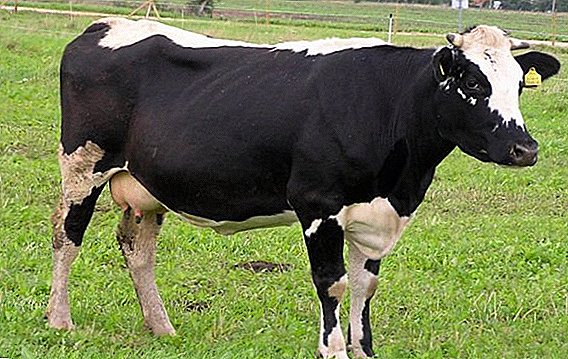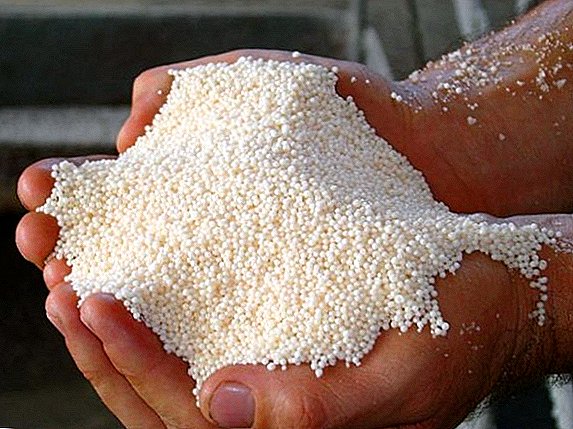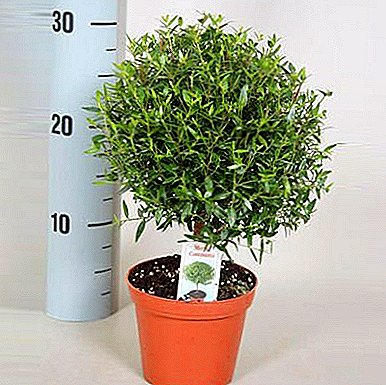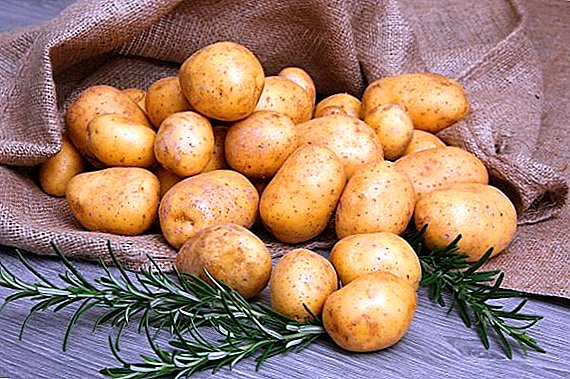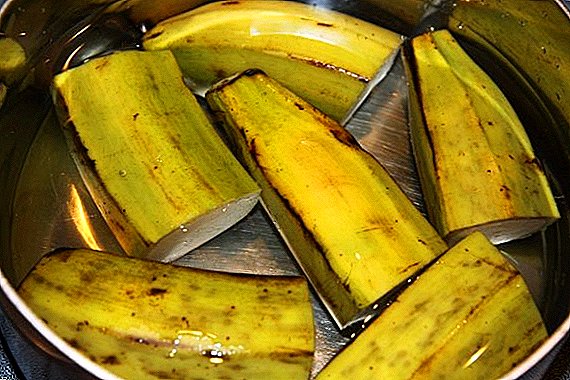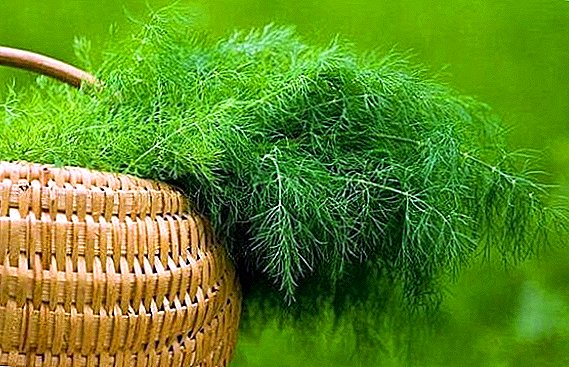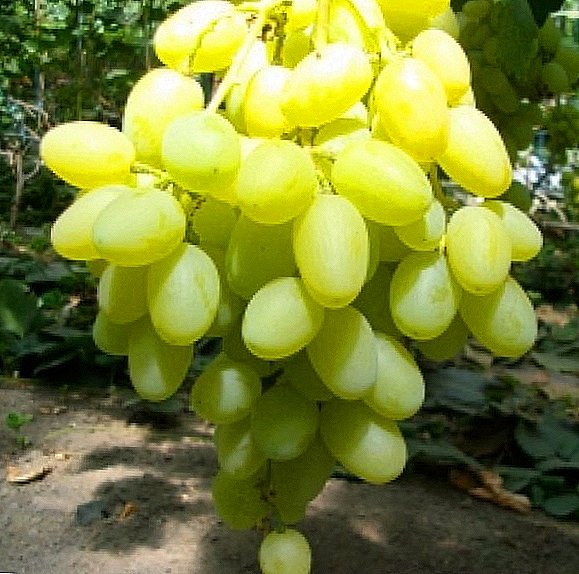
The best grapes are the ones that came to light by the latter.
After all, modern breeders are trying to make every effort to remove as many flaws as possible and improve their new varieties to the ideal.
This is especially true of those winegrowers who themselves are big fans of the fruits of this culture and carry out selection for themselves.
But it is clear that if a new grape turns out to be really worthwhile, it will very quickly become the property of the whole world.
On one of the newest varieties, which is very beautiful name "Lily of the Valley", we will tell you in our article below.
We will tell not only about its varietal features, but also about how to plant it and care for an adult bush.
We get acquainted with high-quality features: fruits, productivity and terms of ripening of "Lily of the valley"

This grape is the result of a selection of an amateur grower named Zagorulko.
Thus, it is more correct to call “Lily of the Valley” not a variety, but a hybrid form that was obtained from such parental forms as “Kishmish Radiant” and “Talisman”.
This grape is valued for the appearance and taste of the fruit, rather than for sustainability.
Refers to table grapes, because it is best suited for fresh consumption. This grape form has been zoned to a greater extent in the southern region, since the Ukrainian city of Zaporizhia is native to it.
Brushes of grapes "Lily of the valley": what is special and distinctive?
Grape brushes of this hybrid form are very attractive because they have almost the correct shape of an elongated cone - cylindrical or elongated-conical.
At the same time, according to the structure, they are moderately friable, with a fairly large number of berries.
The average weight of one bunch is about 0.5 kilogram, although larger ones are more common.
Berries "Lily of the Valley" have an elongated-oval-cylindrical shape, which is found only in this form. Also, their characteristic feature is a slightly pointed tip. In size berries can be not just large, but even very large. The average values of their parameters are 3.6 x 2.2 centimeters. At the same time, the average weight of a single grape can be up to 14 grams. Outwardly, these berries are also very different yellow-lemon color of the skin.
But the main advantage and distinction of this grape is the taste and aroma of the pulp. After all, very sweet berries have a very lasting and pleasant taste of nutmeg, which is very harmoniously combined with the scent of flowers of lily of the valley and white acacia.
It is very important that the taste of nutmeg in the berries remains unchanged even when it is grown on different soils and in different regions of the territory of Ukraine. Also, with regard to taste, you should pay attention to the fleshy-juicy structure of the pulp, which we give the berries a special tenderness.
But the sweetness of the fruit of the "Lily of the Valley" clearly shows the sugar content of the pulp: about 17-19%, with acidity levels of just 5-7g / l. The skin of these berries, although quite dense in structure, is practically not felt in food.
Answer the question, when and how to ripen the harvest of grapes "Lily"?

In terms of ripening terms, this hybrid of grape varieties belongs to the early-medium grapes. Full removable ripening of the fruit usually occurs in the average time, although in general the growing season of the Lily of the Bush lasts about 125-135 days. Thus, the harvest is removed from the bushes only in late August and even in early September.
Fruiting grapes described form in general is high. A large role in this is played by the presence of a vigorous shrub and the excellent maturity of its shoots.
The advantages of grapes "Lily of the valley" should be attributed to stability of fruiting bushesBecause, due to the presence of bisexual flowers, the pollination of the bush occurs independently and independently of other grape varieties.
Positive features of the grapes "Lily of the valley": for what the variety is so fond of growers
- The grapes have a unique taste, good and regularly fruits.
- It reproduces well and simply, which is greatly facilitated by the excellent rooting and survival rate of cuttings of the Lily of the Valley. Saplings this form also multiplies very well.
- Crops ripen well in medium terms and can persist on bushes for a long period of time without loss of quality. In addition, the fruits of this grape are stored for a very long time even after cutting from a bush: in cold conditions, berries and grapes can retain almost original appearance until the end of winter.
- Relatively high resistance of bushes to frosty temperatures. In general, a bush without damage transfers the temperature to -21 ° C, but when building film corridors during the winter period, it does not even freeze -30 ° C.
- A great option for growing grapes in open areas, as well as in the summer cottage area, near your own home.
Disadvantages of the hybrid form of grapes Zagorulko
Of course, it is almost impossible to create an ideal grape variety in fruiting and sustainability. Zagorulko’s “Lily of the Valley” also, in spite of all its advantages, has some drawbacks, although some winegrowers are in a hurry to attribute to him the characteristic of “complex-sustainable”.
First, it is a poor knowledge of the stability of the bushes and the fruits of the grapes. Despite the fact that according to preliminary data, the resistance of the "Lily of the Valley" to oidium and mildew is average, depending on the weather conditions of a particular year, it may manifest itself in a completely different way. Thus the bush requires constant preventive treatmentswhich are held every year 3 times.
Secondly, another disadvantage, which can sometimes significantly affect the fruiting of the bush, is its narrow zoning. In this regard, it is not yet known how, for example, this hybrid form will behave in the conditions of the middle or northern climatic zone of Russia.
Also, the question of which formations of the Lily of the Bush are best able to bear fruit is not fully understood.
However, at the same time that all the above facts remain the disadvantages of the described grapes, each of us has the opportunity to independently explore it, and come to our own conclusions about the peculiarities of growing Zagorulko grapes.
It is also interesting to read about the best varieties of early grapes.
Grapes "Lily of the Valley" on a private plot: tell how to plant a bush

It is quite simple to propagate the bushes of grapes, because absolutely all variants of planting material take root very easily and adapt to new growth conditions. This is especially true of grapes "Lily of the Valley", about the features of planting which we are going to tell in detail.
But, first of all, we will introduce you to the methods of propagation of grapes, so that you can decide which of them is best suited specifically for you.
- Use for breeding seedlings. The easiest and most common method, especially in cases where the grapes are planted on the plot for the first time. Allows you to grow a pure varietal shrub, without admixture of the qualities and characteristics of other grapes. However, the growth of seedlings will be gradual and moderate, when planting a two-year-old seedling, the first fruiting usually occurs only in the 3rd year (if not later).
- Reproduction of grape varieties with the help of its cuttings grafted on the roots of each other varieties. A very effective way, because it allows the bush to grow much faster and begin to bear fruit. All this provides a stock that already has a developed root system and a stock of wood that has already matured well. But, this method can change some varietal properties of the cutting.
- The use of grape taps. In this case, the material for propagation of a grape bush is its own shoots, which bend down to the soil and fall asleep with a small amount of it. With good watering and warm weather, the escape is sure to take root, and from time to time it will be possible to grow a full-fledged bush.
- Growing grape seedlings from seed. Quite a simple way, but compared to all the above, is the most stretched in time. In particular, fruiting will be delayed by at least another 2 years.
How to create the right conditions for planting and growing grapes "Lily of the valley": we select a good place

Grape bushes are recommended to grow only in well-lit areas, which, also, will be protected from cross-winds of the north. The best option for this culture would be its landing on the south side of the plot, near the wall of a house or other building.
In addition, you need to pay attention to the terrain: grape bushes are very afraid of the stagnation of large masses of cold air, which can usually form in lowlands and valleys. For this reason, planting vines should be carried out on low hills or simple mounds of soil.
Since we have already mentioned the soil, it is worth paying attention to the fact that grapes best take root and bear fruit on light and fertile soils. It is especially good to plant bushes of this crop in black soil, although it is also grown quite successfully on other soils.
The most important point, which is most important to take into account, is the level of groundwater occurrence: if they rise above 2.5 meters, be sure to dig out a drainage system at the site into which excess water would flow.
Laying a large vineyard and discussing the scheme of planting vines
Even if you are going to plant on the site only 2 bushes of grapes, you must take into account the scale of their future growth and plant at a certain distance from each other.
Since the Lily of the Valley bushes have very strong and intensive growth, they need a lot of space. With that, not only for the shoots, but also for the roots. Thus, the distance between the bushes of the same row should be at least 3 meters, although ideally it is better to make 4. And between several rows of vine plantations it is necessary to retreat to an even wider distance - about 5 meters.
A little about the timing of planting grapes "Lily of the Valley"
This grape can be planted without problems from the earliest spring to the late autumn.
Dormant planting materials, that is, saplings and cuttings that are in a state of rest, are planted at the most extreme specified periods. In warmer springtime, up to the very first June days, you can plant already blooming seedlings with leaves. Also, at this time it is possible to make withdrawals.
In the autumn there are some restrictions regarding the timing of planting grapes. They consist in the fact that it is impossible to plant a bush too early, because it can start growing for the winter (and of course be damaged due to this), but it cannot be too late when stable frosts come. In this regard, the most ideal option is planting seedlings and grafting in mid-October.
What you need to know about planting grape saplings: preparation and direct planting

This process, although not very laborious, must take into account a large number of mandatory points. This concerns both the selection and preparation of the seedling itself, and the preparation of the pit.
As for the pit, then:
Its depth should be at least 80 centimeters, with an appropriate width.
A large amount of fertilizers is laid at the bottom of the pit, including fertile soil, humus or compost, superphosphates, nitrogen and potassium salt.
Above the fertilizer there must be another layer of soil that will serve as a buffer between the seedling root and the fertilizer.
The pit is left for several weeks, or even until spring, if it is prepared in the fall.
When the pit is almost ready, you can choose the seedling. The fact that it is ready for planting will be indicated by the white color of the horse system and the green cut on its top. At the same time, only the purchased seedling does not land in a hole, before that it needs to be dipped in water so that it is saturated with a large amount of moisture.
Also, you can apply stimulants for the formation of roots, such as "Gumat".
When planting a seedling in a hole, it cannot be buried more than before the root collar. The pit is filled up very carefully so as not to damage the roots. But at the same time, the soil should lie tightly enough so that there are no gaps in the air in it.
After planting, a support is driven in near the grape seedling, it is poured with plenty of water, and the soil around the headquarters is mulched.
We plant grapes "Lily of the valley" to the rootstocks
The most responsible in this is the preparation of the cuttings themselves, since they are easily damaged. The cutting should consist of 2–3 ocelli, the lower part of it is trimmed on both sides and lowered into the water for several days. If you are vaccinating in the fall, it is advisable to wax the stalk.
You should not prepare a stock in advance, you can do this right on the day of grafting.
First, it is necessary to remove the old bush, leaving only 10 centimeters in height after it, the cut surface should be even, it should be further cleaned and all dirt should be removed.
The most important thing is to make a neat split exactly in the middle of the stock. This should be done with a small and sharp ax. There should not be a deep split, as this may adversely affect his health.
Next, the stalk is placed in the split. Deepen it costs only a trimmed part. The stock after this is very tightly tightened with a cloth or rope. The vaccination site is smeared with wet clay, which will keep moisture in it longer. After that, all the same actions that were carried out after planting a grape seedling.
Basic steps for the care of the grape bush on its own site
- Grapes like moisture, which it needs to feed in the spring and during periods of droughts.
- The soil around the trunk must be mulched with moss or sawdust.
- It is necessary to start feeding the bush only from the moment the bush begins fruiting. The same fertilizers are used as for laying in the pit.
- Crop every fall, removes up to 10 buds on each shoot.
- It is necessary to cover a bush for each winter, for this you can even use simple sugar bags.
- Regular preventive spraying against mildew and oidium, which are carried out before the flowering of the bush and during the formation of peas on the inflorescences


